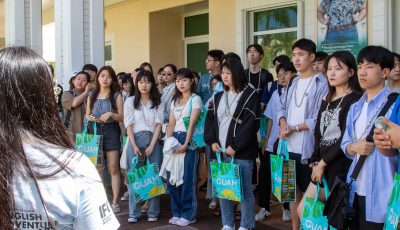Arrivals up at 17 pct. in October
Visitor arrivals to the Marianas jumped 17 percent in October 2017 compared to October 2016, continuing the destination’s double-digit monthly increase trend.
According to the Marianas Visitors Authority’s numbers, arrivals to the islands totaled 48,950 in October 2017, compared to 41,910 visitors received in October 2016.
This is the fourth highest arrivals for October in Marianas history, the record being 59,564 in fiscal year 1997.
“October marks a strong first month of growth in the fiscal year, a trend that we expect to continue throughout the year,” said MVA managing director Christopher A. Concepcion. “Overall, we are projecting an estimated 700,000 visitors this fiscal year, based on anticipated flight service and hotel room capacity.”
Concepcion also commended the Division of Revenue & Taxation, the Zoning Office, and the Department of Fire & Emergency Medical Services for recent enforcement of the hotel occupancy tax.
“One of the areas of focus for the industry in the year ahead will be ensuring the proper licensing and taxation of all AirBnB rentals, guest houses, and other hotel rooms,” he said. “The MVA’s budget is derived from hotel occupancy tax, so we need this enforcement in order to meet our projected budget, carry out our programs, and help keep the tourism economy strong.”
Arrivals from Korea increased 20 percent in October with 24,411 visitors. Korea is projected to be the top-performing market for the second year in a row, buoyed by strong air service. One full service carrier and three low cost carriers or LCCs—Asiana Airlines, Jeju Air, Jin Air, and T’way Air—currently provide Incheon-Saipan flight services.
Also, Jeju Air will operate daily Busan-Saipan flight services beginning on Dec. 15, 2017, and T’way Air, which operates five weekly flights to Saipan, plans to increase to daily ICN-SPN services beginning on Dec. 7, 2017.
As the result, a total of 49,140 seats per annum will be added by these two LCCs to the Marianas.
Arrivals from China grew 15 percent compared to October 2016 to 17,671 visitors. Airport advertisements in Beijing, Guangzhou, and Hangzhou and advertisements on the QYER app continue to attract more tourists after the National Day holiday period.
In addition, road shows held by Century Tours and the MVA in Shenyang and Datong attracted many travel agencies to promote the tourism products of the Marianas.
Arrivals from Japan were 6 percent lower than October 2016 at 3,411 visitors. Delta Air Lines has announced plans to use larger aircraft on its daily flight from Tokyo-Narita beginning Nov. 5 through March 2018, adding 24 additional daily seats. Discussions with other airlines for additional service from unserved cities have brought some issues to light, including limited slot availability for regularly scheduled flights, wariness by travel agents to assume complete financial liability for charter flights, Japanese dissatisfaction with the destination, and more.
The Marianas also received 603 visitors via two military ship arrivals in October.
Economic highlights
South Korea’s economy is expected to grow at 2.8 percent this year, according to the Korea Economic Research Institute, which has lowered its estimate from an earlier forecast of 2.9 percent. The average U.S. dollar/won exchange rate in October was 1,135.39 won, a slight increase from the previous rate of 1,128.61 won in September.
The Chinese economy continues growth. The yuan/dollar exchange rate remains stable and inflation remains very low at around 1.5 percent, meaning favorable conditions for travel to the Marianas. Additionally, with the seasonal slowing of outbound in November, prices are dropping for FIT and tour packages to island destinations short term.
Japan Prime Minister Shinzo Abe managed to uphold his two-thirds supermajority in the Oct. 22 snap election. Abe’s strong mandate paves the way for him to revise the country’s pacifist constitution, and he is on track to become the longest-serving prime minister in Japan’s history. On the economic side, Abe will continue with the implementation of his set of policies aimed at boosting Japan’s inflation and long-term growth, dubbed Abenomics. Monthly average exchange rate for the U.S. dollar to Japanese yen in October 2017 was 112.89, compared to 110.65 in September 2017. (PR)



























